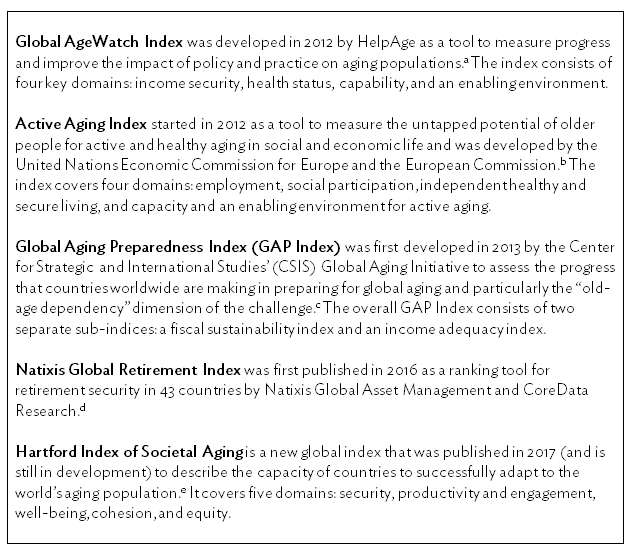
The rapid pace of aging in developed and developing countries, especially in Asia, requires data for informed decision-making to ensure the well-being of aging populations. But for many countries, data for sound policy-making, planning, and investment targeting have not been available. This has led to piecemeal public policies with little sense of priority.
Multilateral and nongovernment organizations have developed several global aging indexes that focus on various aspects of aging and well-being. The indexes cover mostly Organisation for Economic Co-operation and Development (OECD) countries and selected emerging economies. But none of these indexes seem to (i) capture well-being in its entirety or (ii) provide enough information on the systems (e.g., health care, long-term care, housing, post-retirement employment, safety, and security) that will ensure the well-being of the elderly.
What is well-being?
Today, many people recognize that standard macroeconomic indicators, such as gross domestic product, fail to give a true account of people’s current and future well-being.1 The OECD’s work on measuring well-being culminated in 2011 with the launch of the Better Life Initiative and the Better Life Index. The index looks at what life is like for people by measuring 11 key aspects—not just their income and jobs but their housing, environment, social network, work-life balance, personal security, education, health, whether they feel part of the democratic process, and their level of satisfaction with life in general.2
Depicting well-being and its determinants
Measuring progress in well-being provides information on the impact of policies and programs for an aging population. But to design effective policies, data on well-being need to be complemented with information on factors that influence well-being. Figure 1 illustrates this point by means of a house, The House of Well-being:
- The roof represents the macro level as proposed by the Center for Stra¬tegic and International Studies’ (CSIS) Global Aging Initiative. It includes two parts: (i) countries’ fiscal sustainability (projections of government old-age benefit spending, fiscal room, and the degree of elderly dependence on public benefits); and (ii) the elderly’s income adequacy (trends in the living standards of the elderly, including labor-force participation and informal family support).3
- The indoor space includes the systems that need to function properly to respond to the elderly’s expectations in old age. These include appropriate housing and transportation, adequate health care and social care, safety, food and income security, and employment in old age. Each of these systems can be measured in terms of its sustainability, continuity, quality, and integration as perceived primarily by the elderly.
- The foundation and walls of the house represent the multidimensionality of well-being geared towards the elderly.
All elements of the house are linked and need to be monitored over time to generate evidence on well-being and its contributing factors. If this approach is successful at the country level, it could be standardized over time and become the basis for a global or regional index.
Figure 1: The House of Well-being

Source: Author.
What are some of the global aging indexes?
The indexes in Box 1 have been developed and published recently.4 This is not surprising as aging issues have generally not been on the priority lists of most countries. But aging is becoming a pressing issue in countries such as the People’s Republic of China, Thailand, and Viet Nam, which have rapidly aging societies and are relatively unprepared. The Sustainable Development Goals set out by the United Nations have helped to put aging issues clearly on the world stage.
Box 1: Selected Global Aging Indexes

a http://www.helpage.org/global-agewatch/about/global-agewatch-index-version-20/
b https://statswiki.unece.org/display/AAI/I.+AAI+in+brief
c https://www.csis.org/analysis/global-aging-preparedness-index-second-edition
d https://ngam.natixis.com/us/research/global-retirement-index-2017
e http://agingsocietynetwork.org/hartford-foundation-project
Source: Summarized by the author.
Do the global indexes overlap with the House of Well-being?
By looking at Figure 2, one can easily conclude that each index covers the House of Well-being only partially and that the indexes overlap to some extent. This points to the need to merge existing indexes or create a new one to cover all aspects of aging to overcome the piecemeal approach to preparing for an aging society seen in many countries.
Figure 2: Scope of Global Indexes and the House of Well-being

Source: Author.
Three additional aspects in developing a relevant aging index
Three additional aspects should be at the center of the development of an index:
- Sustainability and future well-being. Existing indexes provide data mainly about the current situation and do not sufficiently project the future or measure system sustainability (e.g., social security, health, long-term care, transportation).
- The preferences of the elderly. A well-being index could include weights for each key aspect of life. These weights could be made adjustable to individuals’ preferences or, better still, constituencies’ preferences. This, in turn, would lead to policy development based on people’s preferences.
- Democratic processes. Developing a well-being index cannot be left to politicians or technocrats alone. The choices of the main dimensions of well-being require the direct involvement of the various components of society (including the young and the elderly). This provides democratic legitimization for the measures chosen to represent the factors of well-being and the priorities for political action.5
Conclusion
Each of the existing global aging indexes has the potential to contribute to evidence-based policy-making. However, none capture well-being in its entirety, nor do they inform sufficiently about the systems (health, long-term care, housing, etc.) that will ensure the well-being of the elderly. Countries could avoid much of the current piecemeal policy-making by referring to a dashboard providing information on the elderly’s well-being that focuses on people’s preferences, sustainability, and the future, in line with the House of Well-being.
_____
1 https://en.wikipedia.org/wiki/Commission_on_the_Measurement_of_Economic_Performance_and_Social_Progress
2 https://en.wikipedia.org/wiki/OECD_Better_Life_Index
3 https://www.csis.org/analysis/global-aging-preparedness-index-second-edition
4 To select relevant indexes, the author searched the World Wide Web using several key words, such “aging index”, “global aging index”, “well-being index,” and reviewed relevant literature from World Health Organization, International Labor Organization, UNESCAP, and OECD, etc. in September 2017
5 http://www.oecdbetterlifeindex.org/blog/creating-equitable-and-sustainable-well-being.htm and https://link.springer.com/chapter/10.1007%2F978-94-007-3898-0_2







Comments are closed.